January 4 - 10, 2015: Issue 196
Malley's and Sons Ltd. - A Munificent Australian Family Company
"Sunrise" 10 Gallon Milk Can - currently for sale ($220) from The Antiques Store - West Pymble
Other sellers of Malley's milk cans suggest turning them into letterboxes or using them as flowerpots for 'unique garden displays'.
Francis Malley and Sons Ltd. - A Munificent Australian Family Company
In Portable Ice-Boxes and Coolers – How Many Claim This Invention as Theirs? we weaved a small path through one of Australia's very necessary inventions, a way to keep produce and drinks cool.
One of the proponents of what is still called the 'esky' was invented as a brand-name for and icebox by the Malley's company, a business formed by a gentleman born just over the water, at Gosford, Francis Malley.
Although this company is another great representation of all Australians can do, and will do, as shown in the range of products they eventually made or sold even when made by others, it began like all good things with one person and their aptitude to use their own hands, skills and acumen and be prepared to work, coupled with determination. Of interest to all who like collecting, preserving or recycling Australian made products if the interste and many uses made of their milk cans - fetching anywhere from $60- $300 or more, these are touted as great for turning into letterboxes, as planters in the garden or simply just as themselves for the heritage value attached and memories of when milk was so pure cream capped it.
A few sentences about Francis Malley which allow us to glimmer some of that journey:
MR. FRANCIS MALLEY.
Mr Francis Malley founder of the firm of Malleys, Ltd., Sydney, died at his home, Kareela-road, Cremorne, on Sunday, aged 69 years. Mr. Malley was a native of Gosford. After learning his trade in Sydney, he carried on business for 20 years on his own account. His business eventually became a limited liability company. He retired in 1912, leaving the firm under the direction of two sons, Messrs. Charles L. and Clyde Malley. At one period of his life Mr Malley took an active interest in the municipal affairs of Mosman, where he had resided for 45 years. He was an alderman of one of the early Mosman councils and was a foundation member and a trustee of the Warringah Bowling Club.
The remains were cremated at Rookwood yesterday, after a service by the Rev. D. P. Macdonald, of the Mosman Presbyterian Church.
Besides members of the family, others present were:- Messrs. B. Crewes and C. Benson (representing the staff of Malleys, Ltd., John Heine, president, and W. C. Myhill, secretary, Metal Trades' Association, F. Kennedy, A. V. Elliott, J.Bishop, C. Motson, A. Trott, Charles Bruce (Baldwins, Ltd), C. Whiddon, Charles Gillham, R. Merritt, L. R. Davis, T. W. King, A. Henderson, H.McLachlan, R. Wadley, J. A. Spencer, S. T. Jones, R. S. Higgs, R. Millard, L. Noaakes, Norman C.Oakes, William Atkins, T.K. Smith, C. Cornwell, John Ewing, J. S. Dwyer, J. A. Chuey (representing the Chinese Consul-General), Dr. W. P. Chen), O. Roy, J. Gregory, D. Banks, D. W. Smith, A. Buckle,G. Bell, W. R. Armstrong, J. Armstrong, G. Park-hill, H. A. Scholer, E. Elliott, J. Patrick, H.Baker, A. R. Joseph, A. W. Jones, W. McKeown,A. W. Bye, D. Brown, Lea-Wright, E. C. Goulding, J. Levy and R Twohill. MR. FRANCIS MALLEY. (1932, June 29). The Sydney Morning Herald (NSW : 1842 - 1954), p. 15. Retrieved from http://nla.gov.au/nla.news-article16921965
What this tribute doesn't share is that the two sons, Charles and Clyde, who ran the company before and after their father's retirement were twins, both born in 1885. Clyde was born first. Besides these two first born sons, two other sons, Garnet F (1892) and Roy N (1895) and two daughters, Sylvia V (1887) and Coral I were born to Francis and Clara Malley (nee Merritt: note that some records state her first name as Ellen then C for Clara) - married 1883.
Both Roy and Garnet served in WWI, Garnet Francis Malley, MC, AFC, of which this is more in Extras below, was an Australian fighter ace of World War I, credited with six aerial victories. He was an aviation adviser to Chiang Kai-shek's government in China during the 1930s, and an intelligence officer in World War II. (1)
Roy, a 'sheet metal worker' prior to enlistment, was a member of the 18th Battalion, 18th Reinforcement and 8th Training Squadron Australian Flying Corps. The Malley's home was at Mosman.
The article below indicates how much was happening and how quickly for this newly married couple:
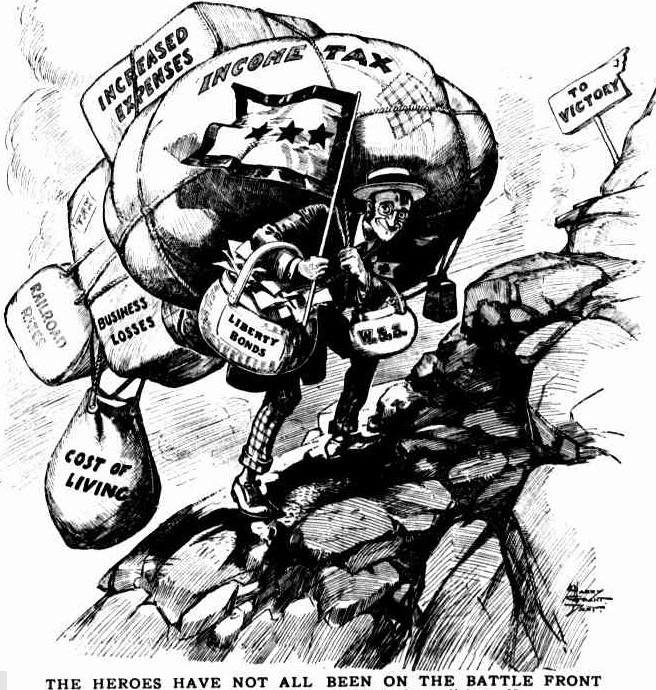
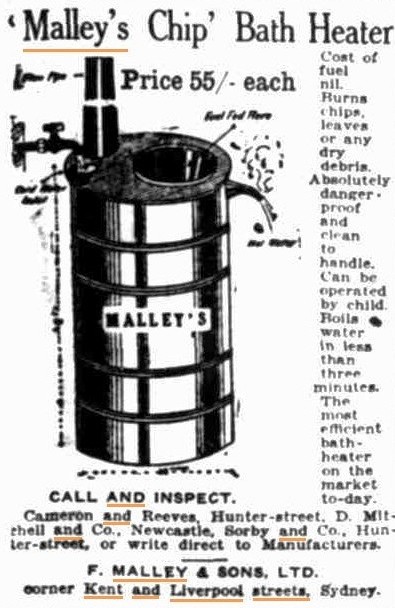 In No. 3 Court an appeal was made on behalf of the Secretary of New South Wales Amalgamated Tin-smiths and Sheet Metal Workers' Society, against the decision of the Chief Industrial Magistrate in the case of P. G. Maxwell (Sec.)against F. Malley & Sons, Ltd., sheetmetal manufacturers of Kent and Liverpool Streets, Sydney, for an alleged breach of the award of the Iron and Shipbuilding Trade; this was dismissed with 2/2/costs on account of unsatisfactory evidence. P. G. Maxwell's second appeal was also dismissed. The Housing Problem. (1918, November 25). Construction and Local Government Journal (Sydney, NSW : 1913 - 1930), p. 5. Retrieved fromhttp://nla.gov.au/nla.news-article109674466
In No. 3 Court an appeal was made on behalf of the Secretary of New South Wales Amalgamated Tin-smiths and Sheet Metal Workers' Society, against the decision of the Chief Industrial Magistrate in the case of P. G. Maxwell (Sec.)against F. Malley & Sons, Ltd., sheetmetal manufacturers of Kent and Liverpool Streets, Sydney, for an alleged breach of the award of the Iron and Shipbuilding Trade; this was dismissed with 2/2/costs on account of unsatisfactory evidence. P. G. Maxwell's second appeal was also dismissed. The Housing Problem. (1918, November 25). Construction and Local Government Journal (Sydney, NSW : 1913 - 1930), p. 5. Retrieved fromhttp://nla.gov.au/nla.news-article109674466 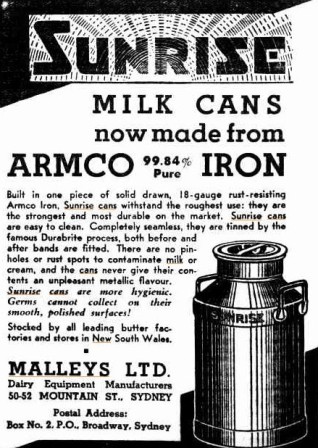 The old-established firm of Malleys Ltd., of Mountain Street, -would not be what it is if the policy of the firm were not thorough. Malley's Standard Monthly Price List supplies 20 pages of prices of goods supplied by the firm, but as few people would look through this long list to see whether any alteration in prices had been made since the last issue, the front page has a list of alterations and additions which will save a lot of time and trouble. Galvanised corrugated iron, terra cotta chimney pots, locks and hinges, ventilating bricks, baths, sinks, etc., are amongst the many items of interest to the building world; whilst milk cans and other such goods appeal to specialists. In reading through these catalogues the fact is forcibly brought home to us what advances have been made of late years in cleanliness, sanitation and health matters. A list of about 80 places in and round Sydney is given where this firm's 'All Red' exhaust fans and complete air systems are installed, which should give confidence to prospective users on the service this firm renders. Such a simple means of getting rid of dust and shavings makes us almost wonder why every factory and workshop does not make use of if as well. Malley's Catalogue and Monthly Price List would be worth anyone's while to have handy, and their address in Mountain Street, is easily found. MALLEY'S CATALOGUE. (1930, February 19). Construction and Local Government Journal (Sydney, NSW : 1913 - 1930), p. 11. Retrieved fromhttp://nla.gov.au/nla.news-article133475689
The old-established firm of Malleys Ltd., of Mountain Street, -would not be what it is if the policy of the firm were not thorough. Malley's Standard Monthly Price List supplies 20 pages of prices of goods supplied by the firm, but as few people would look through this long list to see whether any alteration in prices had been made since the last issue, the front page has a list of alterations and additions which will save a lot of time and trouble. Galvanised corrugated iron, terra cotta chimney pots, locks and hinges, ventilating bricks, baths, sinks, etc., are amongst the many items of interest to the building world; whilst milk cans and other such goods appeal to specialists. In reading through these catalogues the fact is forcibly brought home to us what advances have been made of late years in cleanliness, sanitation and health matters. A list of about 80 places in and round Sydney is given where this firm's 'All Red' exhaust fans and complete air systems are installed, which should give confidence to prospective users on the service this firm renders. Such a simple means of getting rid of dust and shavings makes us almost wonder why every factory and workshop does not make use of if as well. Malley's Catalogue and Monthly Price List would be worth anyone's while to have handy, and their address in Mountain Street, is easily found. MALLEY'S CATALOGUE. (1930, February 19). Construction and Local Government Journal (Sydney, NSW : 1913 - 1930), p. 11. Retrieved fromhttp://nla.gov.au/nla.news-article133475689 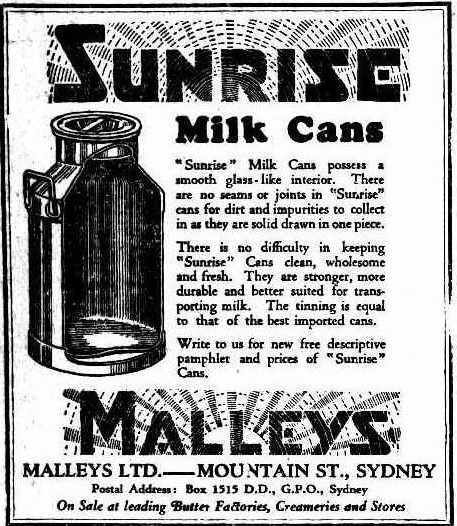
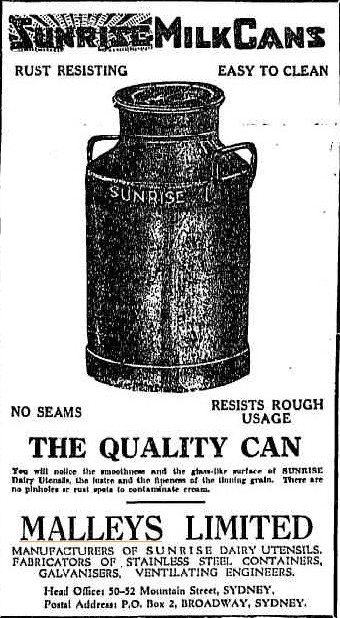 Malley 's, Limited. Registered Office: MOUNTAIN STREET, SYDNEY....... Directors: Charles L. Malley, Clyde Malley, Edward P. M. Sheedy. The arrears on preference shares to April 30, 1934, are shown at £7,780, but the directors have passed any immediate distribution in respect to this amount. With a continuance of improved conditions, the directors state that they should soon be able to rectify this position. The only alteration in liabilities is an increase of £9,441 in sundry creditors, but there is an increase of £7,647 in sundry debtors. Bank has improved by £5,823.Gross profit was £8,320 higher at £40,830, and a net profit of £1,912 is shown for the year's trading. This compares with, a loss of £3,116 for the previous year. Malley's, Limited. (1934, July 13). Daily Commercial News and Shipping List (Sydney, NSW : 1891 - 1954), p. 3 Supplement: WEEKLY FINANCIAL SUPPLEMENT. Retrieved fromhttp://nla.gov.au/nla.news-article161144755
Malley 's, Limited. Registered Office: MOUNTAIN STREET, SYDNEY....... Directors: Charles L. Malley, Clyde Malley, Edward P. M. Sheedy. The arrears on preference shares to April 30, 1934, are shown at £7,780, but the directors have passed any immediate distribution in respect to this amount. With a continuance of improved conditions, the directors state that they should soon be able to rectify this position. The only alteration in liabilities is an increase of £9,441 in sundry creditors, but there is an increase of £7,647 in sundry debtors. Bank has improved by £5,823.Gross profit was £8,320 higher at £40,830, and a net profit of £1,912 is shown for the year's trading. This compares with, a loss of £3,116 for the previous year. Malley's, Limited. (1934, July 13). Daily Commercial News and Shipping List (Sydney, NSW : 1891 - 1954), p. 3 Supplement: WEEKLY FINANCIAL SUPPLEMENT. Retrieved fromhttp://nla.gov.au/nla.news-article161144755
Right Sunrise Milk Cans: Advertising. (1935, September 20). The Land (Sydney, NSW : 1911 - 1954), p. 14. Retrieved from http://nla.gov.au/nla.news-article104199766
The above article was published after what is considered by historians as the worst year of The Depression in Australia, 1933. It seems the company was not immune to what other businesses went thrugh in the 1933-1934 year. They soon rallied however:
AN INVESTOR'S DIARY. Fluctuating Profits' of Malleys Ltd. By PHAROS. Malley’s, Ltd., which describes itself as sheet-metal engineers, manufacturers of builder’s and plumbers' hardware, sanitary ware, milk and cream cans, dairy utensils, "all red" fans, copper boilers, and enamelware, in its accounts for the year ended April 30th last, disclosed a record profit or £28,945. Dividends of a per cent, on ordinary and preference shares absorbed £18 408, leaving a balance of £18, 346 to be transferred to reserves. AN INVESTOR'S DIARY. (1938, July 12). The Sydney Morning Herald(NSW : 1842 - 1954), p. 8. Retrieved from http://nla.gov.au/nla.news-article17481509
Being purveyors of building products, it should come as no surprise that what was to become a scourge in Australian homes and factories, and what is still claiming lives in the form of mesothelioma and asbestosis, a product that dates back 750, 000 years, and was first mined in Australia in Jones Creek, New South Wales, in the 1880s, was also among the items sold by Malleys:
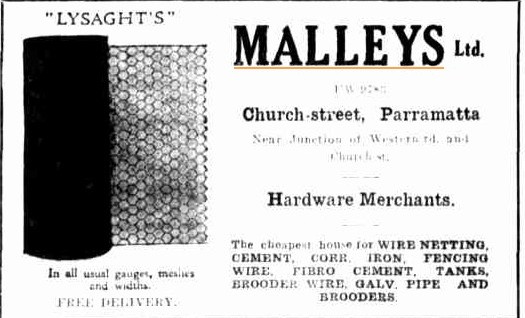
Fibro Cement: Advertising. (1932, June 9). The Cumberland Argus and Fruitgrowers Advocate (Parramatta, NSW : 1888 - 1950), p. 17. Retrieved from http://nla.gov.au/nla.news-article105924586
Along with the products advances made they were famous for, bath heaters and milk cans, came fridges built to last:
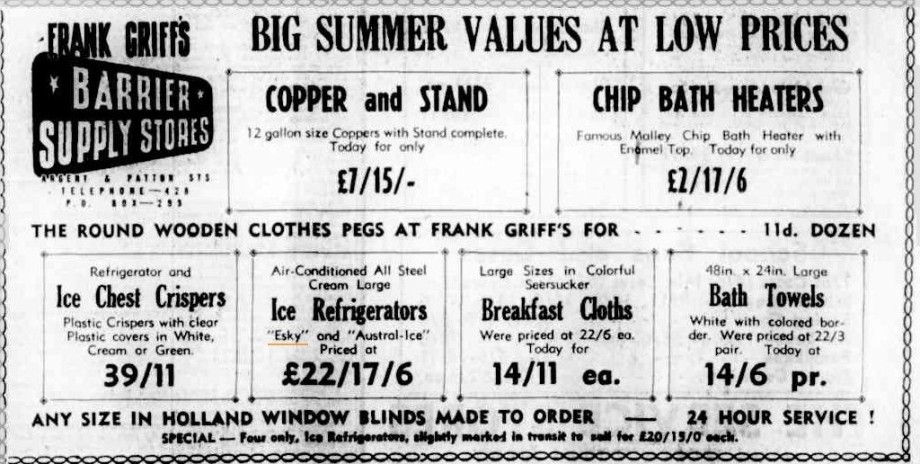
Above: Advertising. (1952, January 25). Barrier Daily Truth (Broken Hill, NSW : 1908; 1941 - 1954), p. 3. Retrieved fromhttp://nla.gov.au/nla.news-article141206756
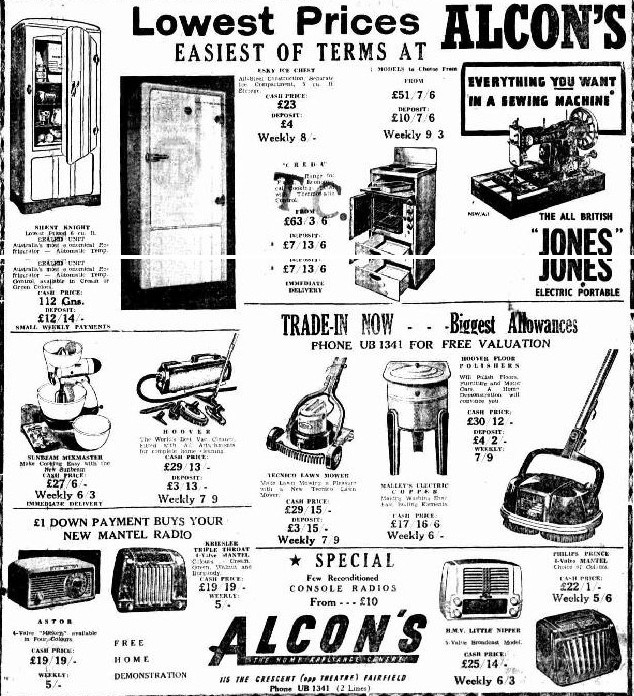
Paying off a fridge/ice-box on terms: Advertising. (1952, October 9). The Biz (Fairfield, NSW : 1928 - 1954), p. 16. Retrieved fromhttp://nla.gov.au/nla.news-article75597392
Keep your picnic lunch cool and fresh in the new "Esky" Auto Box. Take it on the beach, on a picnic, out driving. It's light and Compact. Price £5/17/6. Advertising. (1952, December 22). Northern Star (Lismore, NSW : 1876 - 1954), p. 4. Retrieved fromhttp://nla.gov.au/nla.news-article96458114
Take Your Frig . . . TO THE PICNIC! TO THE BEACH or OUTDRIVING! ESKY AUTO BOX is a compact Portable Ice Box, ideal for keeping food and drinks icy cold, and fresh, wherever you go. With a removable three tray food rack, androom for 6 one-pint bottles and finished in lustrousgreen enamel, this Auto Box is a MUST for Outings. £5/12/6 plus Freight! Display Advertising. (1953, December 8). The Canberra Times(ACT : 1926 - 1995), p. 6. Retrieved from http://nla.gov.au/nla.news-article2902571
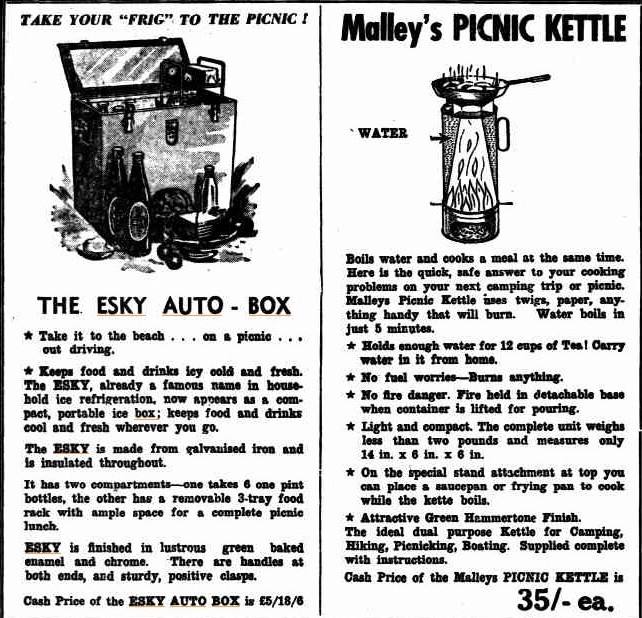
Esky Auto Box and Picnic Kettle: QLD: Advertising. (1954, August 20). Morning Bulletin(Rockhampton, Qld. : 1878 - 1954), p. 7. Retrieved from http://nla.gov.au/nla.news-article57336359
The early 1950's also brought another instance of the perils of business:
Fire Guts Factory At Auburn - FIREMEN play a hose on a fire which destroyed a block at Malleys Ltd. factory in Auburn yesterday. The fire destroyed hundreds of milk cans, which can be seen at the side of the factory block. Fire yesterday afternoon caused damage estimated at £50,000 to a block of Malleys Ltd. factory in St. Hilliers Road, Auburn.
The fire broke out about 3 p.m. and engulfed the block in about 15 minutes. Electric presses and electric welders were destroyed. Damage to the building was estimated at £30,000. Stock and machinery destroyed were valued at £20,000.
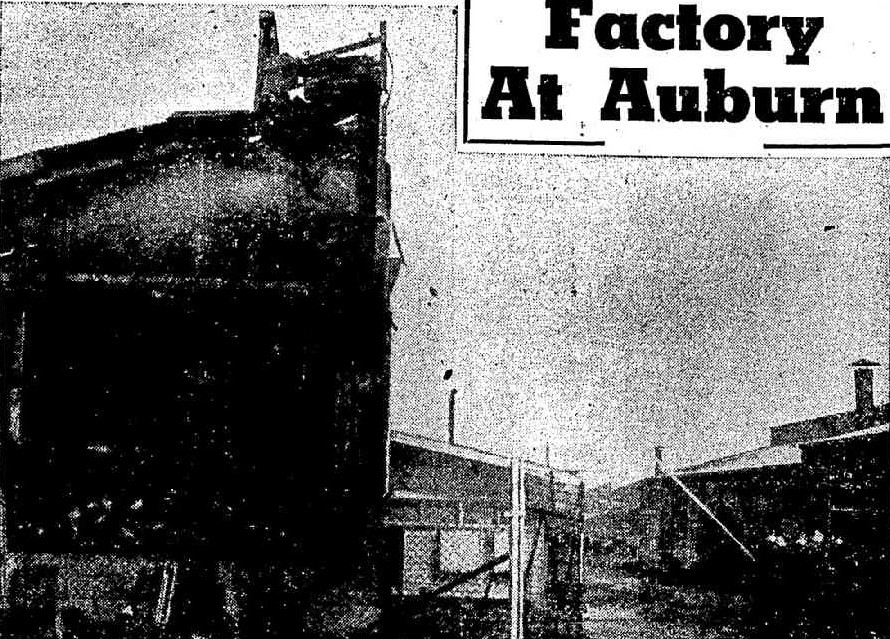
Started In Roof
The fire started in the roof on the northern side of the building. Spread by a westerly wind, the flames were half-way through the building before firemen arrived. Brigades from Parramatta, Lidcombe, Auburn, Burwood, Stanmore and Head-quarters, under Executive Officer H. W. Pye, attended. They stopped the flames from spreading to an adjacent block, which also housed valuable machinery and equipment.
Power Lines Down
Hundreds of large milk cans, ready for shipment overseas, were destroyed or damaged. They were worth £5/10/ each. Police from Auburn cordoned off St. Hilliers Rd, while firemen fought the blaze. They kept back hundreds of spectators. The fire brought down overhead telephone lines and County Council officers had to cut off electric power. The cause of the fire is unknown. C.I.B. detectives of the Arson Squad will begin investigations to-day. Fire Guts Factory At Auburn. (1953, December 13). The Sun-Herald (Sydney, NSW : 1953 - 1954), p. 3. Retrieved from http://nla.gov.au/nla.news-article28657973
Malley's Ltd. was taken over by taken over by Simpson Pope Holdings Limited on July 25th, 1979, following an early redemption and the company delisted on 14th of September 1983.
Such was the quality of Malley's products that many people still advertise fridge parts (Whirpool Company) or the repair of Malley's fridges as part of their services. The 'Tuckerbox' freezer and Malley's range of fridge/freezer combinations, by then very sleek in design and look, continued to be sold under their brand name:
Advertising. (1981, September 30). The Canberra Times (ACT : 1926 - 1995), p. 4. Retrieved from http://nla.gov.au/nla.news-article126848969
The catchphrase for advertising material, 'Has your mum got a Whirpool?' became part of the Australian lingo and an indication of the high esteem the Malley's products were held in.
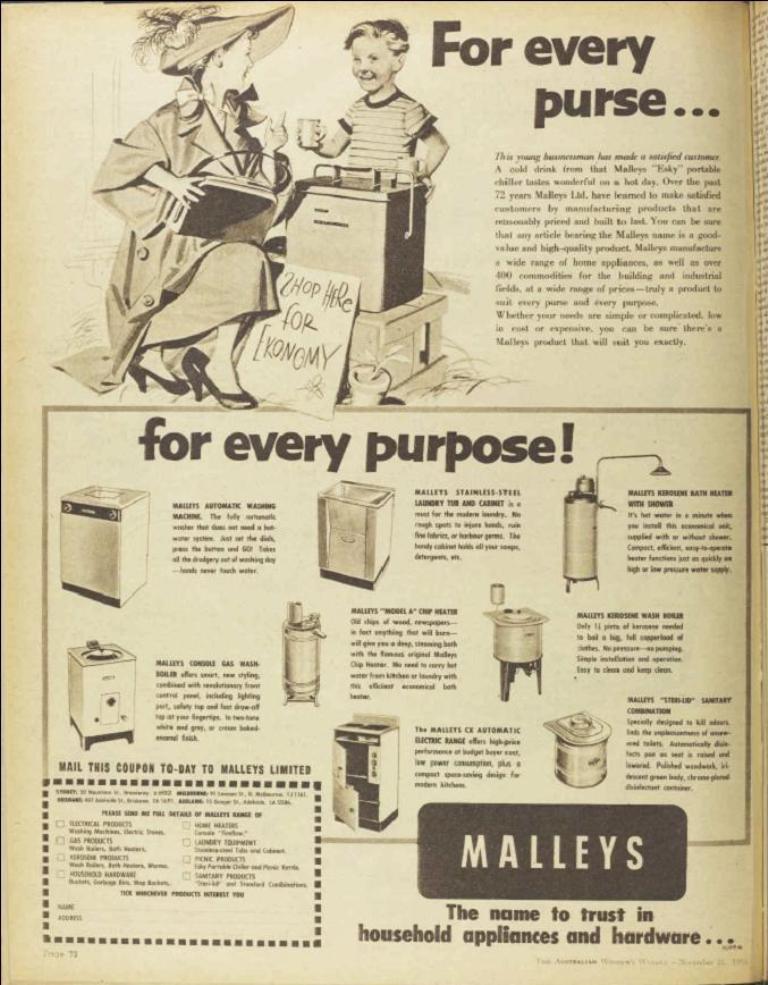
Full page advertisement showing all products - For every purse... (1956, November 21). The Australian Women's Weekly (1933 - 1982), p. 72. Retrieved from http://nla.gov.au/nla.news-article42111504
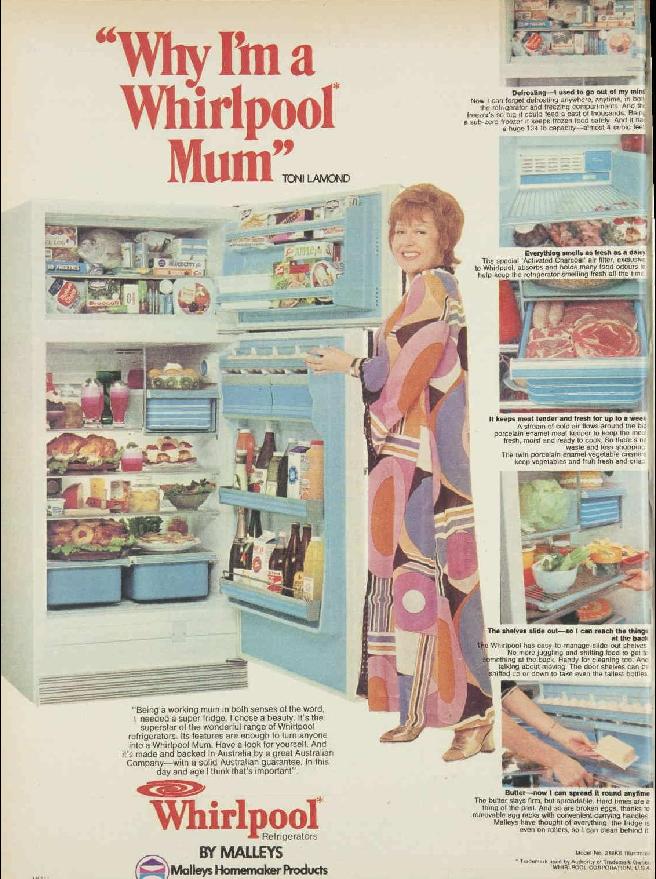
Whirlpool mums: Advertising. (1974, October 23). The Australian Women's Weekly (1933 - 1982), p. 48. Retrieved from http://nla.gov.au/nla.news-article51385651
Extras:
AN INDUSTRY CONSOLIDATES, BUT . . . White goods still in dark
By RAY FRAWLEY
The Australian electrical-appliance industry, often referred to as the whitegoods industry, has just undertaken a major restructuring, but what this means to the consumer is difficult and premature to estimate. However, one thing is clear: there are now only four major Australian manufacturers whereas there were seven a little over a month ago.
The effects on prices are not as clear cut. Industry and department sources were reluctant to speculate on how the restructuring would affect prices on the showroom floor, but one indication came from the Industries Assistance Commission, which conducted a three-year inquiry into the industry.
In its report of February, 1978, to the Government, the I AC said a restructured industry would use its resources more efficiently and thus provide national benefits in terms of real wealth.
"Price of the appliances to consumers should be lower in relative terms than at present", the report said.
Another indication came from a spokesman for the Adelaide-based company Simpson Pope Holdings Ltd, which was one of the key companies involved in the restructuring.
Speaking last week from Adelaide, he said, "Obviously the range will not change. As a result of what we are doing the price situation is likely to change by getting economics of scale. It is bound to react to the advantage of consumers".
He said this would be contrary to the views held by some consumers, who no doubt thought that less competition would mean higher prices.
"We are competing on an international market", he said.
The restructuring of the industry is in line with government policy and appears to satisfy the requirements of the IAC. The rationalisation of the industry, which produces refrigerators, washing machines, freezers, clothes dryers and air conditioners, was highlighted by almost-daily stock exchange and board-room battle during the past month.
The four remaining major Australian manufacturers are Rank Industries-AGE Appliances, Email-Kelvinator, Hoover and Simpson-Pope-Malleys.
This is quite a change from 20 years ago when, for example, the Australian consumer had the choice of 18 refrigerator manufacturers.
The past month has seen Email Ltd acquire a controlling interest in Kelvinator Australia; Australian General Electric (Appliances) Pty Ltd has announced a merger with Rank Industries Australia Ltd, the new company to be known as Rank General Electric Pty Ltd; and on Thursday Simpson Pope Holdings Ltd finalise a deal lo give it a controlling interest in Malleys Ltd.
Some idea of the size of the Australian market can be gained from the IAC report into the industry: there were 480,000 refrigerators marketed in 1976-77, of which about 215,000 were imported; the figure for washing machines was about 465,000, of which about 165,000 were imported; and for room air conditioners the figures were 120,000 marketed and 80,000 imported.
Commenting on the rationalisation moves, a spokesman for the Department of Productivity said on Thursday that his department was in favour of actions — including rationalisation — that would ensure the continued viability of Australian industry.
The department was pleased to see this occurring in the white-goods industry, as an industry initiative.
"What is happening is in line with government policy, which was made clear in the Government's recent announcement following the Industries Assistance Commission's inquiry into white goods", he said.
The problems of the industry as seen by the IAC are high production costs, stemming from inefficient use of resources, particularly labour, which in turn results from too many producers and too many models. The commission said the significant changes in the structure of the industry were necessary.
"For example, there are seven manufacturers of refrigerators whereas the commission believes there should be no more than three", it said in its report on the industry.
The establishment by the Department of Productivity of a White-Goods Industry Program Group is a result of the IAC inquiry. The group is made up of representatives of all major manufacturers, except Simpson Pope, which elected not to participate, unions and the department. Similar groups have been set up to look at the footwear, clothing and textile industries.
According to a departmental spokesman all have a common aim, which is to ensure economic efficiency for the industry. The government decision of the IAC report, which was handed down in July last year, endorsed an IAC recommendation for greater rationalisation of the industry.
In a statement announcing the decision, the Minister for Business and Consumer Affairs, Mr Fife, and the Minister for Industry and Commerce, Mr Lynch, said two objectives were considered: the first was that, if industry were to survive its economic difficulties, plant must be allowed to increase — only in this way could the industry obtain the economies of scale needed to compete against imports at reasonable levels of protection; the second was that restructuring needed to take place within the industry if it was to have a long-term future. BUSINESS & ECONOMICS. (1979, April 18). The Canberra Times (ACT : 1926 - 1995), p. 22. Retrieved from http://nla.gov.au/nla.news-article110941216
Miss Laurel Noakes, second daughter of Mr.and Mrs. James Noakes, of Willesden, Military-road, Mosman, was married to Mr. Charles L. Malley, son of Mr. F. W. Malley, of Elowera, Harbour-street, Mosman. The service was choral, and when the bridal party adjourned to the vestry Miss Myrle Noakes, sister of the bride, sang "A Song of Thanksgiving." The church was beautifully decorated by members of the choir, and Mr. Augustus Gehde played the Wedding March. The Rev. E. N. Wilton,B.A., Prescentor of St. Andrew's Cathedral, performed the ceremony, assisted by the Rev. F.W. Reeve, rector of St. Luke's. The bride worea princess robe of ivory duchesse satin, with sleeves and corsage of silk embossed fishernet, and a coronet of orange blossoms and Brussels lace veil. Her shower bouquet and diamond and emerald ring were the gifts of the bridegroom. The bridesmaids were Miss Ruby Noakes, sister of the bride, and Miss Sylvia Malley, sister of the bridegroom, who wore princesse dresses of cream crape de chine, with yokes of Malines lace and white hats with white feathers. The bridegroom presented a bouquet of pink robes and a turquoise pendant to Miss Noakes, and a bouquet and gold brooch to Miss Malley. Two little maids, Thelma and Enid Noakes, sister and niece of the bride, wore simple white muslin dresses and white silk hats, and carried white satin cushions with the initials of bride and bride-groom in silver They wore gold brooches, gifts of the bridegroom. Mr P. King was best man, and Mr L. R. Davis groomsman. A reception was subsequently held in the Mosman Town Hall, about 150 guests being present. An orchestra supplied music for the dancers, and vocal items were rendered by several of the guests. Later Mr. and Mrs. Malley left for the Jenolan Caves. The bride's travelling dress was of resilda cloth, prettily braided, and worn with a three-cornered hat to match, with cluster of feathers. SOCIAL. (1910, March 19). The Sydney Morning Herald (NSW : 1842 - 1954), p. 4. Retrieved fromhttp://nla.gov.au/nla.news-article15151912
MALLEY—WHIDDON.—September 14, at Presbyterian Church, Manly, Clyde, eldest son of F. Malley, Esq., Elowera, Mosman, to Annie Cordery, fourth daughter of W. H. Whiddon, Esq., Fairlight, Manly. At home25th and 26th October, Capri, Cowles-road, Mosman. Family Notices. (1910, October 22). The Sydney Morning Herald (NSW : 1842 - 1954), p. 12. Retrieved from http://nla.gov.au/nla.news-article15189425
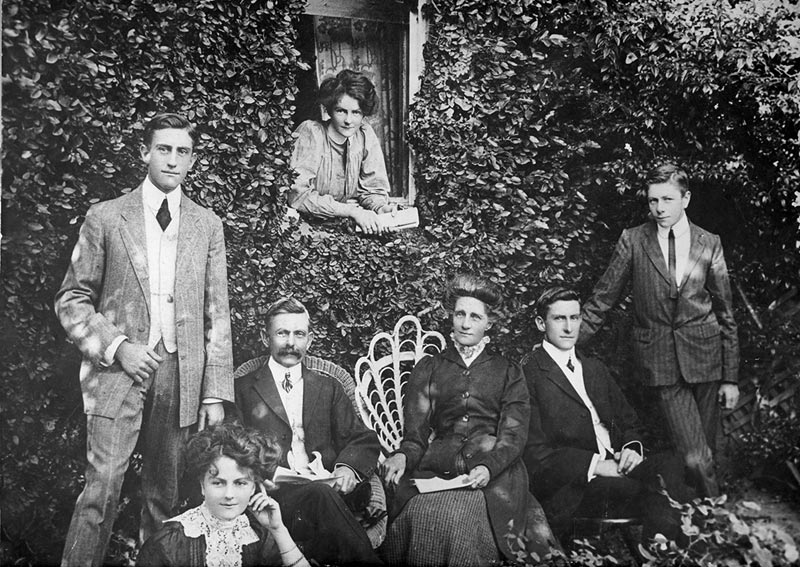
Malley family, possibly at 'Elowera', Mosman, c.1906-1910. Coral (at window), and, left to right, Charles or Clyde, Sylvia, Francis, Clara, Charles or Clyde, and Garnet Malley. (Source: Peter Scholer)
SCHOLER-MALLEY - November 29, 1910, at St. Andrews Cathedral, Sydney, by the Rev. E. N. Wilton, Oscar Marx Scholer, second son of the late J. F. Scholer, Hunter's Hill, to Sylvia, eldest daughter of F. Malley, of Elowera, Mosman. Family Notices. (1911, January 7). The Sydney Morning Herald(NSW : 1842 - 1954), p. 12. Retrieved from http://nla.gov.au/nla.news-article15221566
Garnet Francis Malley, MC, AFC, the second youngest of six children of Clara Ellen Merritt and Francis Malley, was born in Mosman, a suburb of Sydney, on 2 November 1892. His father, an ironworker originally from Gosford, founded the whitegoods firm Malley's. He later served two terms as alderman of Mosman Council. Garnet Malley attended the Church of England Preparatory School in Mosman, The School in Mount Victoria, and Hawkesbury Agricultural College in Richmond. At the outbreak of World War I he was an apprentice mechanic at Malley's.
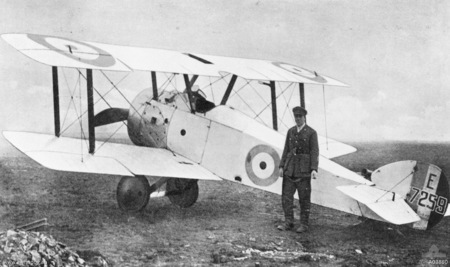 The official history of Australia in the war credits Malley with the destruction of a Pfalz over Wytschaete on 10 May, though it does not appear in other accounts of his final tally. Four days later, he and Lieutenant Roy King each claimed a German two-seater spotting for artillery between Ypres and Bailleul. On 30 May, Malley and Cobby led their flights on a bombing mission in the Lys region, after which they each destroyed a German observation balloon over Estaires. Malley's final victory, over the Lys on 1 June, was a Pfalz D.III.
The official history of Australia in the war credits Malley with the destruction of a Pfalz over Wytschaete on 10 May, though it does not appear in other accounts of his final tally. Four days later, he and Lieutenant Roy King each claimed a German two-seater spotting for artillery between Ypres and Bailleul. On 30 May, Malley and Cobby led their flights on a bombing mission in the Lys region, after which they each destroyed a German observation balloon over Estaires. Malley's final victory, over the Lys on 1 June, was a Pfalz D.III.
Right: Captain Malley with his white Sopwith Camel of No. 5 (Training) Squadron, Minchinhampton, 1918
His official tally was six German aircraft destroyed—four fighters, an observation balloon, and an unidentified observation plane—and he was wounded in action twice, by a bullet through the leg in March, and by shrapnel from anti-aircraft fire in May. He was awarded the Military Cross on 22 June. The citation was promulgated in The London Gazette:
Lt. (T./Capt.) Garnet Francis Malley, Aust. F.C., attd. R.F.C.
For conspicuous gallantry and devotion to duty. When on offensive and low-flying patrol he attacked one of two hostile scouts, which eventually turned over and fell out of control, being seen to crash by another pilot. Later, a general engagement ensued with four enemy scouts, one of which he attacked, with the result that it fell completely out of control and crashed. Prior to this occasion he had also shot down out of control another hostile machine. His courage and able leadership have resulted in his patrol carrying out excellent work under the most adverse conditions.
Malley took temporary command of No. 4 Squadron at the end of June 1918, overseeing its move from Clairmarais North to a new airfield at Reclinghem. In August, he was posted to No. 5 (Training) Squadron AFC at Minchinhampton, England. The squadron was part of the 1st Training Wing, led by Lieutenant Colonel Oswald Watt. Malley's rotation to home establishment was in accordance with Royal Air Force policy requiring pilots to be rested and serve as instructors after nine to twelve months in combat. Known for flying a white Camel trainer, he received the Air Force Cross for his instructional work; the award was promulgated on 3 June 1919.
Inter-war years
No. 5 Squadron was disbanded in May 1919. Along with many other Australian Flying Corps personnel, including sometimes Bilgola resident, Colonel Watt, Major King, and Captain Les Holden, Malley returned to Australia aboard the troopship Kaisar-i-Hind, disembarking in Sydney on 19 June. He subsequently toured the country to promote the Peace Loan.
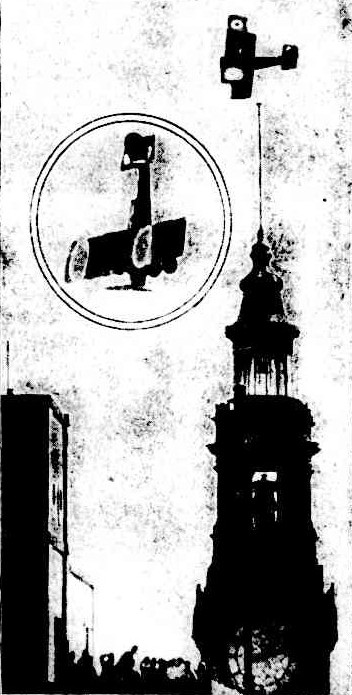 On 24 August, while travelling from Melbourne to Sydney to commence his series of demonstration flights around New South Wales, Malley crashed his Avro 504K during takeoff from Benalla, Victoria. He was uninjured but had to return to Melbourne and eventually made his way north by train. Resuming his aerial program, he was reported on 17 September as having "thrilled" lunch-time crowds in Sydney the previous day with "three daring spiral dives" over Hyde Park.
On 24 August, while travelling from Melbourne to Sydney to commence his series of demonstration flights around New South Wales, Malley crashed his Avro 504K during takeoff from Benalla, Victoria. He was uninjured but had to return to Melbourne and eventually made his way north by train. Resuming his aerial program, he was reported on 17 September as having "thrilled" lunch-time crowds in Sydney the previous day with "three daring spiral dives" over Hyde Park.
Right: AIRMAN ASTONISHES SYDNEY - Captain Malley, M.C., flew among the housetops of the city in aid of the Peace Loan campaign. The main picture shows him hovering over the flagstaff of the General Post Office tower. In the inset he is seen perfoming an exciting nose-dive. AIRMAN ASTONISHES SYDNEY. (1919, October 11). Barrier Miner (Broken Hill, NSW : 1888 - 1954), p. 4 Section: SPECIAL SATURDAY ISSUE. Retrieved from http://nla.gov.au/nla.news-article45536502
Malley was subsequently discharged from the AIF on 4 October 1919, and commissioned a captain in the Commonwealth Military Forces Reserve on 1 July 1920. He rejoined Malley's as a warehouse manager in 1921. In May that year, he served with Les Holden and other veteran pilots as a pall-bearer at Watt's funeral in Randwick. On 25 January 1922, Malley married Phyllis Kathleen Dare in Mosman. The union would produce one son, Maldon. Malley was acknowledged as both a source and a reviewer by F.M. Cutlack in the latter's volume on the Australian Flying Corps, first published in 1923 as part of the official history of Australia in the war.
Malley relinquished his appointment in the Commonwealth Military Forces on 18 June 1925. The following day, he was commissioned a flight lieutenant in the Citizen Air Force, the part-time active reserve of the Royal Australian Air Force (RAAF). He served as a pilot with No. 3 Squadron, which operated Airco DH.9s and Royal Aircraft Factory S.E.5s. Formed at RAAF Point Cook, Victoria, the squadron transferred to the newly opened RAAF Richmond, New South Wales, on 30 June.
From 1925 to 1928, Malley was vice president of the Australian Flying Corps Association. In January 1928, he was promoted to honorary squadron leader, and temporarily commanded No. 3 Squadron in March–April. That year, he gave up his position with Malley's to become an aviation consultant to Australian National Airways (ANA), as well as a director of the company. In January–February 1929, he again temporarily commanded No. 3 Squadron. That April, he was a member of the citizens' committee responsible for organising and funding the search for the Southern Cross and its crew, Charles Kingsford Smith and Charles Ulm, who had force-landed in North West Australia during a flight from Richmond to England. Les Holden eventually located the missing airmen near the Kimberley region. In 1930, Malley transferred to the (inactive) RAAF Reserve.
By 1931, ANA was in financial difficulties and Malley travelled to China to take up a position as an aviation adviser to Chiang Kai-shek's government in Kwangtung. Details of Malley's exact duties over the next five years—a time of civil war and Japanese infiltration—remain uncertain. He spent some time in Australia on holiday in 1936, after which he returned to his advisory role in China. On 1 February 1937, through the influence of the British Foreign Office, Malley's status was enhanced when he was made an honorary wing commander in the RAAF Reserve. He was by now serving as adviser to Madame Chiang Kai-shek, Soong May-ling, in her capacity as secretary-general of the aeronautical commission that directed China's air force; May-Ling extended to Malley her "warmest congratulations" for his "well deserved" promotion. One of the tasks she assigned him was investigating corrupt procurement practices in the government. Malley found that the air ministry was being defrauded by foreign agents and Chinese officials colluding to charge inflated prices for military equipment.
... in attempting to evaluate his role and importance – both within the Australian aviation scene but more particularly the decade he spent in China ... it is plainly inappropriate to dismiss or discount his contribution; yet equally it is not possible to verify all that he claimed, and therefore to attach the same weight or significance as he did in assessing his impact and influence. Historian Chris Coulthard-Clark on Garnet Malley
.jpg?timestamp=1420261391779) Malley's stay increasingly involved him in the fighting in China; his wife would relate three years of night-time air raids to her friends upon the couple's return to Australia in 1940. In May 1938, he advised the Chief of the Air Staff, Air Vice-Marshal Richard Williams: "there is a first-class war on here, which must eventually affect Australia and its defence schemes". Williams and other members of the RAAF may, however, have perceived Malley as exaggerating the importance of his role in China, particularly given his apparent delight in its ceremonial aspects. In one letter, he regaled Williams with stories of an inspection tour around the country, declaring: "I ... can just imagine how much you would have enjoyed it – landing on aerodromes that were all polished up for inspection. Being met by provincial dignitaries and lavishly entertained. I had to drink every conceivable Chinese wine that was ever made, and to eat foods unheard of in Australia!" At any rate, Malley's reports of Japanese air tactics, and the value his observations might have held for Australia in the event of war in the Pacific, were largely discounted by his home government.
Malley's stay increasingly involved him in the fighting in China; his wife would relate three years of night-time air raids to her friends upon the couple's return to Australia in 1940. In May 1938, he advised the Chief of the Air Staff, Air Vice-Marshal Richard Williams: "there is a first-class war on here, which must eventually affect Australia and its defence schemes". Williams and other members of the RAAF may, however, have perceived Malley as exaggerating the importance of his role in China, particularly given his apparent delight in its ceremonial aspects. In one letter, he regaled Williams with stories of an inspection tour around the country, declaring: "I ... can just imagine how much you would have enjoyed it – landing on aerodromes that were all polished up for inspection. Being met by provincial dignitaries and lavishly entertained. I had to drink every conceivable Chinese wine that was ever made, and to eat foods unheard of in Australia!" At any rate, Malley's reports of Japanese air tactics, and the value his observations might have held for Australia in the event of war in the Pacific, were largely discounted by his home government.
Right: Squadron Leader Garnet Malley, New South Wales 1930 (cropped from larger image) Fairfax Corporation - National Library of Australia
World War II and later life
Malley was recalled to Australia in July 1940, departing China with a note of thanks from May-Ling for his "loyal service" before rejoining the RAAF on active service as a squadron leader in October. He became the Air Force representative at the Combined Operational Intelligence Centre (COIC), Melbourne, a tri-serviceorganisation responsible for intelligence collection, analysis and dissemination. Drawing on his knowledge of Japanese raids on Chinese airfields in the 1930s, Malley visited several RAAF stations in northern Australia to advise on protective measures; it became evident in the wake of the attack on Darwin in February 1942 that none of his recommendations had been implemented. COIC primarily handled naval intelligence, so Army and Air Force participation was part-time initially. By April 1941, Malley had been assigned a full-time role, and the RAAF was maintaining a round-the-clock presence. He was promoted to honorary wing commander in October 1941, and two months later succeeded Commander Rupert Long as Director of COIC. Malley was raised to acting group captain on 1 July 1942, but ill health forced him to relinquish his post on 3 October. He was discharged from the Air Force as medically unfit on 9 June 1943. General Douglas MacArthur praised Malley for his "foresight, planning, and organizational ability". The former aviator went on to work as officer-in-charge of the Chinese section at the Commonwealth Security Service in Canberra from January 1944 to March 1947 as an honorary group captain.
In 1948, Malley's war service was recognised by the United States with the award of the Legion of Merit. By 1949, he had procured a yacht, the Royal Flight, which was used as a setting in the film The Blue Lagoon. The following year, the family bought a coconut plantation on Vanua Balavu, Fiji. In September 1951, Malley and his wife toured the world, visiting Algiers, Guadaloupe, Curaçao, Martinique, and Tahiti.[59] They subsequently returned to live on their Fijian plantation, and rode out the 1953 Suva earthquake and tidal wave.
Garnet Malley died of a heart attack on 20 May 1961. Survived by his wife and son, he was buried at sea in an Anglican ceremony. The commander-in-chief of the Taiwanese air force sent condolences, paying tribute to the "invaluable" contribution Malley had made during his decade in China, which would "be long remembered". Garnet Malley. (2014, November 28). In Wikipedia, The Free Encyclopedia. Retrieved from http://en.wikipedia.org/w/index.php?title=Garnet_Malley&oldid=635745493
Roy sounds like he was possibly suffering from PTSD symptoms on his return home from war - this was then called 'shell shock' and people were generally told to 'get on with it':
MERCHANTS WIFE SEEKS DIVORCE -Alleges Drunkenness and Cruelty
EDITH MALLEY, formerly Palmer, of Bradley's Head-road, Mosman, was the petitioner in the Divorce Court to-day for a dissolution of her marriage with Roy Neville Malley, city merchant, on the ground of his alleged habitual drunkenness and cruelty.
The parties were married on October3, 1921. Petitioner, a young woman of refined appearance, said there were two children of the marriage. She was only 18 at the time of her marriage. At that time her husband was in business with his father as a merchant in the city. Mrs. Malley said she left her husband at the end of November, 1929.
Mr. Toose: Did you know before marriage that your husband drank to excess?-He told me that one night he was driving some friends home in his car, and he was so drunk that he could not remember how he got home. Mrs. Malley said that after marriage her husband sometimes told her, when he came home, that he had had 15 or16 whiskies during the day. During the first six months of her marriage life her husband's conduct was such that she told him that he if he did not alter his ways, she would be compelled to leave him.
'FULL OF FIGHT'
'My father,' said petitioner, was Mr P. J. Palmer, of the firm of Palmer and Sons, and he gave me some shares in the firm. My husband wanted me to give them to him, saying he could make better use of them. When I told him I could not touch the capital, he called me a liar, and I subsequently left him I returned to him later.' Petitioner said her husband joined the Warringah Bowling Club, Mosman, about 1924, and after that he began to neglect her.
'When he was sober,' declared Mrs Malley, 'you could not wish for a better husband.' Mrs. Malley said drink always had the effect of making respondent bad-tempered.
'Sometimes,' she added, 'he would come home full of fight.'
Witness said her husband frequently told her the second child was not his, delaring that it was not a bit like him.' He sometimes kept me awake till 3o'clock In the morning wrangling,' she added, 'and would then bring up about the child.' Mrs. Malley, speaking of her husband's drinking habits, said he used to boast to her that he could drink any other man 'under the table'. She also said that he used to threaten to shoot her and then kill himself. She hid his revolver. 'He sometimes kicked me out of bed,' declared petitioner, 'Once he threw a pillow at me and broke some of the cut-glass ornaments on the dressing-table. He also caught me by the throat and threatened to choke me.'
FATHER'S NOSE PULLED.
Mrs. Malley related an incident which she said occurred one Saturday night, when she returned late from a motor trip to Gerringong Beach, and her husband locked up the house and went looking for her.
'My father came to the house later when Mr. Malley was abusing me, and there was a fight,' she said. "They closed and fell. Mr Malley had his legs twined around my father on the ground, and was pulling his nose.' Mrs. Malley said her father had recently died
LETTERS FROM A MAN
Mr. MacMahon cross-examined petitioner regarding letters written to her after her return from a trip to Colombo by an officer named George.' She admitted that when her husband met her on her return, he showed her a letter written to her by a Mr Clapam, whom she had met in Colombo. Mr. MacMahon: Do you remember these words occurring in that letter: 'I am fed up with this -- country, and I am coming out to Australia to take you away. If I have to wait three -- years"?-Yes, that might have been in it. Do you remember these words: 'Do you remember the wonderful nights we had together'?— It was days and nights. Did these words occur: 'If we could only have them over again. At night I am restless, and can't sleep without you?— yes, I think so. Mrs Malley said she had kissed Clapam two or three times. Her husband forgave her, and they destroyed Clapam's letter 'But he took a lot of convincing", she added.
Mr. MacMahon: Do you remember that in that letter there were certain disgusting references?— I don't think there were.
The suit is part heard. Mr. S. V. Toose instructed by Messrs Pietyens. M'Lachla, and Co. appeared for the wife, and Mr. T. P. MacMahon, instructed by Messrs W.R. and F. B. Jones for the husband. MERCHANTS WIFE SEEKS DIVORCE. (1930, May 12).Evening News(Sydney, NSW : 1869 - 1931), p. 8. Retrieved from http://nla.gov.au/nla.news-article117476869
What may interest our younger readers is that during this period of time you could apply for a divorce but it didn't guarantee you would get one. Many of these private matters were played out in courts where public galleries were filled with interested onlookers:
PETITION FAILS MALLEY DIVORCE SUITSYDNEY, Monday. The hearing of the petition by Edith Malley formerly Palmer, for a dissolution of her marriage with Roy Neville Malley, a Sydney merchant, on the ground of habitual drunkenness and cruelty was concluded in the Divorce Court to-day. In dismissing the petition, Mr Justice Owen said he was satisfied that respondent was not an habitual drunkard, and that he had not been guilty of habitual cruelty to his wife. His Honor added, however, that he hoped Malley would take the lesson to heart and abstain from alcohol altogether. Malley was ordered to pay the costs of the suit. PETITION FAILS. (1930, May 20). Newcastle Morning Herald and Miners' Advocate (NSW : 1876 - 1954) , p. 6. Retrieved from http://nla.gov.au/nla.news-article137863246
Death of Chairman: Of Australian United Press. SYDNEY, Sunday.
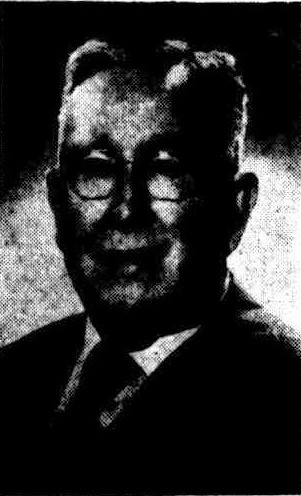 Mr. Edward P. M. Sheedy, chairman of directors of Australian United Press Ltd., died at his home at Kirribilli early to-day after a long illness. The funeral will leave St. John the Baptist Church of England, Milson’s Point, Sydney, for the Northern Suburbs crematorium after a service at 3 p.m. on Tuesday. The service will be conducted by the Bishop of Newcastle, The Rt. Rev. Francis de Witt Batty.
Mr. Edward P. M. Sheedy, chairman of directors of Australian United Press Ltd., died at his home at Kirribilli early to-day after a long illness. The funeral will leave St. John the Baptist Church of England, Milson’s Point, Sydney, for the Northern Suburbs crematorium after a service at 3 p.m. on Tuesday. The service will be conducted by the Bishop of Newcastle, The Rt. Rev. Francis de Witt Batty.
Right: Mr. E. P. M. SHEEDY
Mr- Edward P. M. Sheedy was chairman of directors of Australian United Press Limited. He was also chairman of the "Newcastle Morning Herald and Miners Advocate."
Senior partner of the firm of E. P. M. Sheedy and Son, chartered accountants (Aust.) Sydney, Mr. Sheedy was a respected figure in business life throughout Australia. He entered into public practice in 1903, and engaged professionally in all classes of commercial and industrial activities in Australia.
Mr. Sheedy was, director and financial adviser to many leading trading and manufacturing companies in Sydney and Newcastle. He also served as a trustee of the Church of England Property Trust (Newcastle Diocese).
Mr. Sheedy was proprietor of grazing and citrus orchard property, a packing house and a saw-mill at Niagra Park, N.S:W:, anda breeder of Guernsey cattle. He was a member of1 the 1934-1936 Royal commission appointed by the Federal Government to inquire into the wheat, flour and bread industries.
In 1930, Mr. Sheedy represented the N.S.W. and Queensland Country Press in the Australian delegation to the Empire Press Union Conference in London
Mr. Sheedy began his career as a chartered accountant in 1893. He was a Fellow of the Institute of Chartered Accountants of Australia, and Society of Incorporated Accountants and Auditors-of England.
Born in Sydney on March 2, 1874, Mr.- Sheedy married Mary A. Mapledoran on February 3rd, 1896. He is survived by his widow, three sons and five daughters-E.H. Sheedy, C- K. Sheedy, Mrs. P.S. McDermott, Mrs. J. Mason, Mrs. H.Besley, Mrs. H. Cooke and Mrs. E- Burt.
The chairman of directors of Country Press Ltd., and administrative director of Australian United Press, Mr. E. C. Sommerlad, M.L.C., said tonight that the death of Mr. Sheedy had re-moved a notable personality from the Press world of Australia.
"For many years he was chair-man of "The Newcastle Morning Herald," and it was that association which led him to take an active interest in Press agency organisation as an indispensible adjunct to the modern daily newspaper. Australian United Press has had no other chairman, and in the successive developments Which have marked the progress of that company his guiding hand was always in evidence. 'As one who co-operated with him practically throughout on the A.U.P., I pay tribute to the great value of his work and of the wise counsel which was always forthcoming. "The daily provincial Press of Australia owes him more than it can ever repay." Death of Chairman Of Australian United Press. (1952, June 16). The Canberra Times (ACT : 1926 - 1995), p. 4. Retrieved from http://nla.gov.au/nla.news-article2857514
Mrs. M. A. Sheedy Dead - SYDNEY, Tuesday. - Mrs. Mary A. Sheedy, widow of Mr.E. P. M. Sheedy, well-known city business man and company director, died suddenly at her home in Carabella-street, Kirribilli, tonight. Mr. Sheedy was Chairman of Directors of Australian United Press Ltd. and the "Newcastle Morning Herald." Mrs. Sheedy, with her late husband, was actively associated with the formation of the Palm Beach Surf Lifesaving Club and was a strong supporter of the Red Cross Society. Their eldest son, Mr. E. H.Sheedy, succeeded his father as a director of Australian United Press Ltd. Mrs. M. A. Sheedy Dead. (1952, October 29). Newcastle Morning Herald and Miners' Advocate (NSW : 1876 - 1954) , p. 3. Retrieved from http://nla.gov.au/nla.news-article133556725
STRONG AUSTRALIAN HANDS IN CHINA - By NORMAN STOCKTON, Special Representative of "The Argus" in the Far East.
Strange Tales of Two Men Who Move Behind the Scenes of China's Crowded Politics
[photo] W. H. Donald, the 60-years-old former Australian journalist, is the strong hand behind Chiang Kai-shek's gallant fight against the Japanese invader. This informal picture was taken at Hong Kong.
WHO is this W. H. Donald, the one-time reporter on "The Argus," Melbourne, who has be-come the power behind the throne in China? For months the world hears nothing of him. He disappears behind the curtain of rushing events in the country he has adopted, and is forgotten. Then he reappears, and ephemerally holds the world's headlines, to disappear again into the obscurity that engulfs him in the vastness that is China. Only the diplomats who look after the affairs of Europe know then that Donald has not met the fate of so many foreign advisers to China's war lords.
For 30 years Donald has guided the destinies of China's leaders. He arrived in Hong Kong as a young journalist, one of the hundreds of newspaper adventurers seeking a quick cut to fame bywriting the fast-moving history of the world’s most aged civilisation. He left “The Argus," Melbourne, to become sub-editor on the Hong Kong "China Mail." which rewarded him for his unbounded energy by appointing him managing editor within two years.
Six weeks after the appointment Donald threw in his hand. With the smell of war in his nostrils, he free-lanced his way to Annam, and was the only British correspondent to witness the departure of Admiral Rozhdestvensky and the Russian Fleet for its fateful rendezvous with the Japanese in 1905. No journalist ever saw that fleet again—it was totally destroyed by the Japanese in the Battle of Tsushima, and its destruction ended the Russo-Japanese War.
DR. SUN YAT-SEN, the idealist, who was to become the first President and Father of the Chinese Republic, heard about this young Australian who was making a name for himself as a war correspondent. Sun Yat-sen wanted, above all things, someone who could put the case for republicanism before the world, and Donald readily jumped at the opportunity.
Together they went through the revolution—Sun Yat-sen, the impracticable idealist, and Donald, the practical apologist. It was Donald who saved republicanism for China. His pen, vitriolic or honeyed as the occasion demanded, was mightier than the swords of the Manchus and of the foreign diplomats, whose patronymics made them aghast at the “iniquity" that was to become so commonplace in Europe in 1914-18—when royalty fell by the score.
After Sun Yat-sen's death, ebullient Chang Hsueh-liang, son of the murdered dictator of Manchuria, beckoned to Donald. The Australian served Chang as political and military adviser, and piloted him through a drastic and successful cure for his opium-smoking habit.
It was on Donald's advice that Chang defied the Japanese when they invaded Manchuria in 1932. Chang fought until his troops deserted, and then fled abroad, still accompanied by Donald.
When Donald and Chang Hsueh-liang returned to China the former powerful war lord of Manchuria was without a province. Restlessness at enforced idleness contributed to Donald's decision to accept an invitation from Chiang Kai-shek to become his adviser.
CHIANG KAI-SHEK never regretted the decision that prompted him to invite the Australian to the Central Government's headquarters. On the heels of afresh crisis with Japan, Chiang Kai-shek was kidnapped in Sianfu by Chang Hseuh-liang, who chose this amazing method of gaining control of the political machinery of the north. Donald, as a friend of both parties, did what no other man could have done in China without bloodshed.
He flew by aeroplane to the city where Chiang Kai-shek was held captive, and, heaven knows by what means, prevailed upon Chang Hsueh-liang to release the generalissimo and submit to "discipline.” From that moment Donald's power in China was undisputed. He is probably the only man of the 470,000,000 who in-habit the country who is completely trusted by its dictator. He is constantly with Madame Chiang Kai-shek, who wields as much power in the Republic as her husband.
I met Donald again the other day when he flew with her through the Japanese lines from Chungking to Hong Kong.
While she recuperates from a nervous disorder in a mansion on Hong Kong’s palatial Peak, Donald sits patiently waiting in the city below. You meet him in the lobby of an hotel, and he will sit and talk amicably with you, this former Australian journalist. He neither smokes nor drinks, and yachting is his only pastime. He is about 60 now. His hair is white, and his face is ineradicably burnt by the bitter colds and suffocating heat of 30 winters and summers in China. When you mention Australia his face lights up. Every year he has planned a holiday in Melbourne and Sydney, but China moves too swiftly to spare him from its helm.
He recalls Lithgow, in New South Wales, where his father was mayor. And he recalls Sydney, with its beautiful beaches. But, best of all, he recalls Melbourne, where he spent so many peaceful and tranquil hours before the hurly-burly of Chinese politics claimed him.
"Some day I'll return," he sighs.
WING-COMMANDER GARNETT MALLEY, who was at one time an honorary A.D.C. to Sir Philip Game, Governor of New South Wales, first came to China in 1930, when he organised the Chiang Kai-shek, China's man of destiny, regards thoughtfully the future of his country.
Kwantung Air Force.
He remained with the Kwantung Provincial Government until the commencement of the present war with Japan, when he was offered a post with the Central Government.
TODAY Malley has command of the entire Chinese Air Force, which he is rapidly organising into an efficient, well equipped body. Included in the pilots under his command are 86 European members of an International Air Corps, which includes two Australians and one New Zealander. One of the Australian pilots, J. Whitehead, recently had a miraculous escape from death when his plane was shot down by the Japanese. He is now in a Hong Kong hospital, recovering slowly from bullet wounds received when the Japanese machine-gunned him as he was parachuting to earth.
Royal Australian Air Force pilots will remember Malley for his meteoric rise during the war from a Citizen Force trainee to the acting command of the airbase at Bellevue, and a "bag" of 15 enemy bombers to his credit. Before coming to China in 1930 Malley was manager of a department in Malley's, the Sydney wholesale ironmongers' establishment owned by his father. STRONG AUSTRALIAN HANDS IN CHINA. (1938, March 19).The Argus [photos] (Melbourne, Vic. : 1848 - 1957), p. 1 Supplement: The Argus Week-end Magazine. Retrieved from http://nla.gov.au/nla.news-article11168220
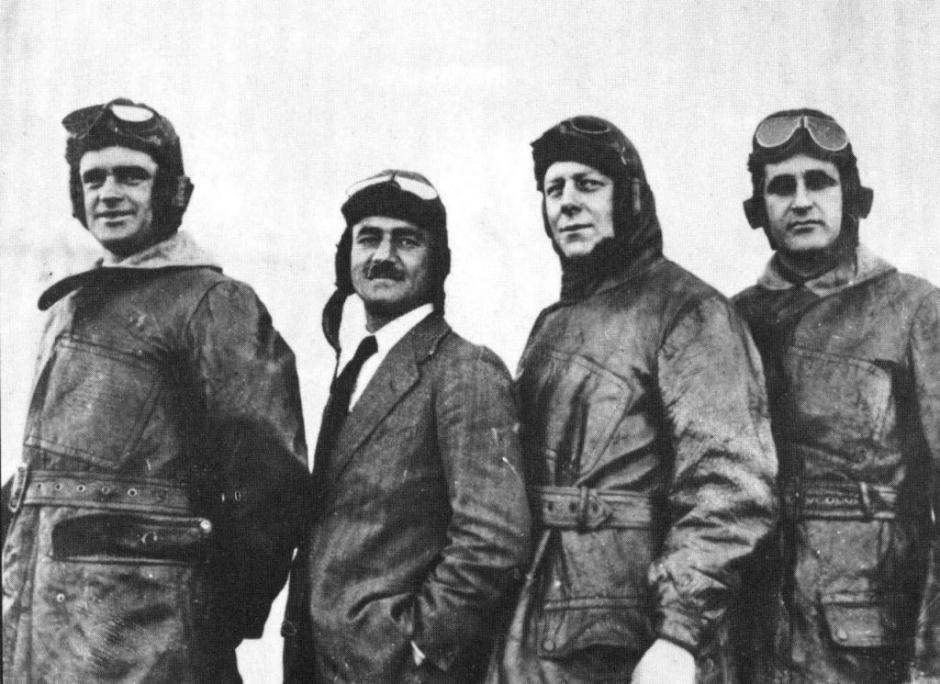
Flight Lieutenant Malley (second right) with Flight Lieutenant Frank Lukis (far left) and other members of No. 3 Squadron, RAAF Richmond, 1925.
Previous Collectors Corner pages:
Blacksmiths and Tinsmiths Nylon Stockings Poster Art Furphy's Water Cart Mousehole Anvil Sapphire One Armed Bandit Gould's 1840 Single and Compound Microscope Tibetan Thangka Wheel Of Life Painting Cast Iron Seats Mabel Lucie Atwell Prints The Customs of Traditional Dining by Hans and Jenny Carlborg Albert Collins Landscape Boomerang Harmonicas Drinking: 18th Century Style Part I by H&J Carlborg Drinking 18th Century Style Part II by H&J Carlborg Fleece Shears Wood Case Crank Telephone 1803 Timepeice Vintage Guitars Milestones No.38RollsRoyceMotorOiler Christmas Postcards Seashells McCormick-Deering Horse Drawn Mower Rope Making Machine Marilyn Monroe 1955 Calendar Stubbie Holders Hill's Hoist Akubra Hat Fowler's Bottling Kit The Bold Autographed Script Fishing Tackle Arnotts Biscuit Tins Comic Books Silver Opium Pipe Mrs Beetons Book Souvenir Teaspoons Bendigo Pottery Gianelli Figurines Key Fobs Model Aircraft-static Porcelain Slippers Wagon Wheels Rhys Williams Painting Chinese Guardian Lions Australian Halfpenny Bud Vases Rolling Stones Still Life LP Autographed WL1895 Thinking Monkey Estee Lauder Ginger Jar Reel Mowers Surf Reels Millers Car Collection Hilton Lingerie - Slips Miniature Books of Verse - A Romantic Tradition REGA Pouring Can R O Dunlop - Sailing At Itchenor Painting Morning Shadows by C Dudley Wood The Father of Santa Claus - Xmas 2012 HMS Penguin Anchor at RPAYC - Newport SS Birubi Mast at RMYC - Broken Bay Helen B Stirling Ship's Wheel at Club Palm Beach Woomeras HMSEndeavour Replica Cannon at RPAYC The Doug Crane Classic Handmade Double Blade Paddle HMS BountyWooden Ship Model Collecting Ladies - Ferdinand Von Mueller and Women Botanical Artists Australian Bark Art Chinese Ginger Jars Hand Plough and Jump Stump Plough - Australian Inventions Frank Clune Books Frederick Metters - Stoves, Windmills, Iron Monger Trinket Boxes 1933 Wormald Simplex Fire Extinguisher is Pure Brass Chapman 'Pup' Maine Engines - Chapman and Sherack The Beach Ball Figureheads – Salty Wooden Personifications of Vessels Binnacle at RMYC The Australian Florin - Worth More Than 20 Cents to Collectors Weathervanes; For Those Passionate About Seeing Which Way the Wind Blows Her Majesty’s Theatre 1962 Programme - Luisillo and his Spanish Dance Theatre Cooper's Sheep Shower Enamel Sign and Simpso's and Sons of Adelaide Jolly Drover Sugar Bowl and English Pottery – A Means to Gaze into the Past Chief Joseph and Edward S Curtis; His Remarkable Images of Native Americans – an Inestimable Record of Images and Portrait Photographs His Masters Voice, Old 78’s and Australia’s Love of Music Jack Spurlings 'Tamar' Picture 1923 Resch's Beer Art - A Reflection of Australiana Now Worth Thousands The Compleat Angler - Izaak Walton’s Discourse Inspires Generations of Fishers Portable Ice-Boxes and Coolers – How Many Claim This Invention as Theirs?
by A J Guesdon, 2015.